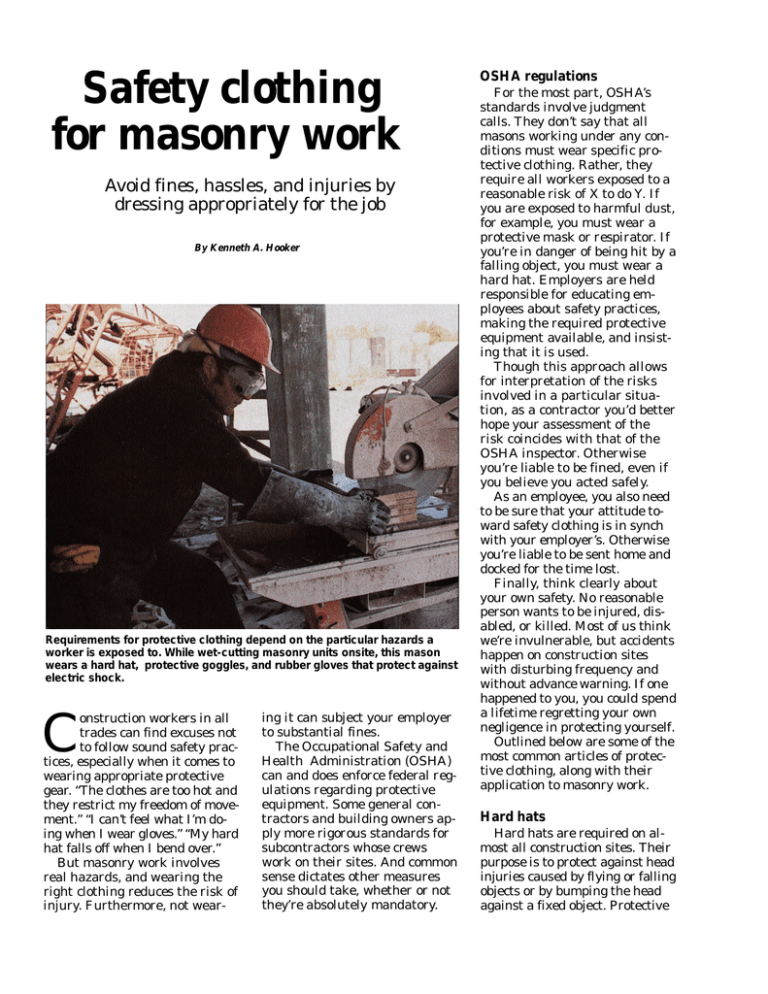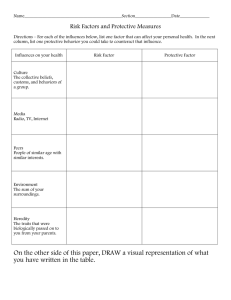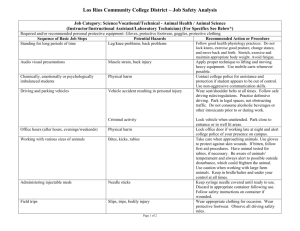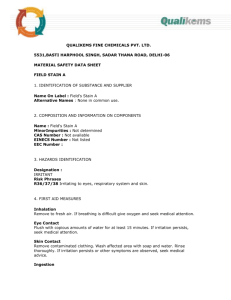
Safety clothing
for masonry work
Avoid fines, hassles, and injuries by
dressing appropriately for the job
By Kenneth A. Hooker
Requirements for protective clothing depend on the particular hazards a
worker is exposed to. While wet-cutting masonry units onsite, this mason
wears a hard hat, protective goggles, and rubber gloves that protect against
electric shock.
C
onstruction workers in all
trades can find excuses not
to follow sound safety practices, especially when it comes to
wearing appropriate protective
gear. “The clothes are too hot and
they restrict my freedom of movement.” “I can’t feel what I’m doing when I wear gloves.” “My hard
hat falls off when I bend over.”
But masonry work involves
real hazards, and wearing the
right clothing reduces the risk of
injury. Furthermore, not wear-
ing it can subject your employer
to substantial fines.
The Occupational Safety and
Health Administration (OSHA)
can and does enforce federal regulations regarding protective
equipment. Some general contractors and building owners apply more rigorous standards for
subcontractors whose crews
work on their sites. And common
sense dictates other measures
you should take, whether or not
they’re absolutely mandatory.
OSHA regulations
For the most part, OSHA’s
standards involve judgment
calls. They don’t say that all
masons working under any conditions must wear specific protective clothing. Rather, they
require all workers exposed to a
reasonable risk of X to do Y. If
you are exposed to harmful dust,
for example, you must wear a
protective mask or respirator. If
you’re in danger of being hit by a
falling object, you must wear a
hard hat. Employers are held
responsible for educating employees about safety practices,
making the required protective
equipment available, and insisting that it is used.
Though this approach allows
for interpretation of the risks
involved in a particular situation, as a contractor you’d better
hope your assessment of the
risk coincides with that of the
OSHA inspector. Otherwise
you’re liable to be fined, even if
you believe you acted safely.
As an employee, you also need
to be sure that your attitude toward safety clothing is in synch
with your employer’s. Otherwise
you’re liable to be sent home and
docked for the time lost.
Finally, think clearly about
your own safety. No reasonable
person wants to be injured, disabled, or killed. Most of us think
we’re invulnerable, but accidents
happen on construction sites
with disturbing frequency and
without advance warning. If one
happened to you, you could spend
a lifetime regretting your own
negligence in protecting yourself.
Outlined below are some of the
most common articles of protective clothing, along with their
application to masonry work.
Hard hats
Hard hats are required on almost all construction sites. Their
purpose is to protect against head
injuries caused by flying or falling
objects or by bumping the head
against a fixed object. Protective
headgear must do two things—
resist penetration and absorb the
shock of a blow. OSHA-approved
hard hats conform to ANSI standard Z89.1-1969 (Ref. 1).
A properly fitting hard hat
should be raised slightly off the
head so it can cushion and absorb blows. The bands inside the
hat should be adjusted so that
the hat fits properly and rests in
a fairly level position.
Hard hats should be available
at all times, but they need not
be worn under certain circumstances. When working on garden walls or other projects isolated from other trades, masons
may not be required to wear
hard hats. Some contractors allow masons to go without hard
hats if they’re working at the
top of the wall and no work is in
progress overhead.
Safety shoes
Leather work boots offer more
protection than gym shoes or
sneakers and are required on
most jobsites. Safety boots protect against injuries caused by
dropping heavy objects on the
foot, or by stepping on sharp objects or scraps of masonry materials. Boots also help protect the
ankles from scrapes and bruises.
Eye protection
OSHA requires eye protection
equipment whenever there is a
reasonable probability that an injury could be prevented by its use.
In normal brick- and block-laying,
eye protection generally is not required. Certain operations, though,
present distinct risks of eye injury
and thus call for the use of protective goggles or other eye protection.
Among these activities are:
■ sawcutting units or walls
■ grinding or chipping out mortar joints for tuckpointing
■ splitting stone
■ any other work that presents a
danger of chips or dust flying
into the eyes
OSHA-approved eye protection
must conform to ANSI Z 87.1-
1968 (Ref. 2). Individuals who
wear corrective glasses must wear
face shields, goggles, or spectacles
of one of the following types:
the trauma to the hands caused
by using a chip hammer or other
device that produces prolonged
and violent vibrations.
■ glasses with protective lenses
that provide optical correction
■ goggles worn over corrective
spectacles without disturbing
the adjustment of the spectacles
■ goggles that incorporate corrective lenses mounted behind
the protective glasses
Other protective clothing
Respiratory protection
Respiratory protection is required to prevent occupational
diseases caused by breathing air
contaminated with harmful dust,
smoke, mist, gases, and vapors.
Again, masonry work results in
such exposure only when certain
tasks are performed. Masons and
laborers should wear dust masks
or other approved respiratoryprotective devices when they are
engaged in grinding or sawcutting operations.
When using any chemical
agents, mortar additives, cleaning chemicals, and the like,
follow the manufacturer’s recommendations with regard to protective equipment and other safety
measures. Mixing and spraying
certain chemicals can put you at
risk of respiratory damage, so
take any necessary precautions.
Gloves
Work gloves protect hands
from cuts and scrapes caused by
handling rough-textured masonry
units. They also can help prevent
chemical burns from exposure to
fresh mortar. Though gloves are
not ordinarily required for masonry work, they often are useful.
In some cases, work gloves of
specific types are required.
Rubber gloves and boots should
be worn to reduce the risk of electric shock when wet-sawing or
working with other power tools in
the vicinity of water.
Protective gloves with vibration-deadening silastic in the
palms and fingers can help ease
Though OSHA generally does
not require it, sensible work
clothes can help prevent injuries
and contribute to a safer jobsite.
Mason and author Richard T.
Kreh makes specific recommendations in his book, Safety for
Masons (Ref. 3):
■ Wear long pants of medium- or
heavyweight material to protect legs from scrapes and cuts.
Avoid cuffs that can catch on
scaffolding.
■ Wear a shirt for protection
from welding sparks and flying
masonry chips. Keep sleeves
rolled up or buttoned so they
don't catch on objects.
■ Dress appropriately for the
weather, but avoid loose or
bulky garments that can restrict free movement and catch
on objects.
Besides these safety concerns,
some contractors and building
owners prohibit masons from
working in shorts or without a
shirt for the sake of decorum.
References
1. ANSI Z89.1-1969, “Requirements for Industrial Head Protection,” American
National Standards Institute, 1430 Broadway, New York, NY 10018.
2. ANSI Z87.1-1968, “Practice for Industrial
and Educational Eye and Face Protection,”
ANSI.
3. Richard Kreh, Sr., Safety for Masons,
Delmar Publishers Inc., Box 15-015, Albany, NY 12212.
PUBLICATION #M920136
Copyright © 1992, The Aberdeen Group
All rights reserved




